Notes
This article includes a list of references, related reading or external links, but its sources remain unclear because it lacks inline citations .(January 2018) (Learn how and when to remove this template message) |
| History | |
|---|---|
| Name: |
|
| Namesake: | Winnipeg and Dominion of Canada |
| Owner: | Patterson Steamship Co. of Fort William |
| Builder: | Globe Iron Works |
| Launched: | 1899 |
| Out of service: | 1967 |
| Fate: | Scrapped |
| General characteristics | |
| Class and type: | Laker |
| Tonnage: | 4,661-long-ton (4,736 t) |
| Length: | 430-foot (130 m) |
Windoc was the name of two Great Lakes freighters owned by Canadian shipping company N.M. Paterson & Sons Ltd., with the second ship named in memory of the first in 1986. Both ships suffered similar accidents with lift bridges on the Welland Canal.
The first Windoc began as the M.A. Hanna in 1899, a 430-foot (130 m), 4,661- long-ton (4,736 t ) steamer built by Globe Iron Works that could carry approximately 7,000 long tons (7,100 t). It was reconfigured and sold to Interlake Steamship Co. in 1913, when it was rechristened the Hydrus (2). A previous Hydrus foundered earlier that year, with all hands lost. After a decade moving primarily coal and ore, Interlake Steamship modernized its operations with four new ships, and sold the Hydrus and 11 other ships to Patterson Steamship Co. of Fort William. It was refitted and rechristened the Windoc in the spring of 1927. The vessel's name comes from the city of Winnipeg, where the owner's head offices were based, combined with the fleet suffix doc, referring to the Dominion Of Canada. Its first transit through the Welland came in 1937, where it made frequent grain and coal runs until it was retired and sold for scrap in 1967.
In October 1938, C.N.R. Bridge #20, a vertical lift bridge spanning the Welland Canal near Humberstone, was lowered onto the Windoc before it had safely passed. Considerable damage was done to the ship's spar, stack, and lifeboats, and the cabins and hold were flooded, but no injuries were reported, and the ship was repaired.
This article includes a list of references, related reading or external links, but its sources remain unclear because it lacks inline citations .(January 2018) (Learn how and when to remove this template message) |

The Welland Canal is a ship canal in Ontario, Canada, connecting Lake Ontario and Lake Erie. It forms a key section of the St. Lawrence Seaway and Great Lakes Waterway. Traversing the Niagara Peninsula from Port Weller in St. Catharines to Port Colborne, it enables ships to ascend and descend the Niagara Escarpment and bypass Niagara Falls. The name currently refers to the fourth such canal, three earlier and much smaller canals servicing the same route are also known as the Welland.
Canada Steamship Lines (CSL) is a shipping company with headquarters in Montreal, Quebec, Canada. The business has been operating for well over a century and a half.
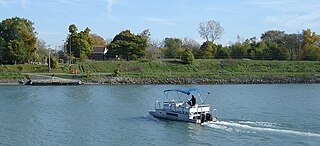
Port Robinson is a small community in the southernmost part of Thorold, Ontario, Canada. The community is divided in half by the Welland Canal, as there is no bridge in the immediate vicinity to connect the two halves of the community. In the summer, a small free ferry for pedestrians and cyclists runs across the canal. In the winter, residents must use the bridge on Highway 20, which results in a 13.3 km (8.3 mi) trip to get to the other side.

Col. James M. Schoonmaker, formerly Willis B. Boyer, is a lake freighter that served as a commercial vessel on the Great Lakes for much of the 20th Century. Named for Medal of Honor recipient James Martinus Schoonmaker, it is currently a museum ship in Toledo, Ohio.

MV Paul R. Tregurtha is a Great Lakes-based bulk carrier freighter. She is the current Queen of the Lakes, an unofficial but widely-recognized title given to the longest vessel active on the Great Lakes. Launched as William J. De Lancey, she was the last of the 13 "thousand footers" to enter service on the Great Lakes, and was also the last Great Lakes vessel built at the American Ship Building Company yard in Lorain, Ohio.
MS Windoc was a Lake freighter or laker, initially constructed as an ocean-going bulk carrier in West Germany in 1959. Entering service that year as Rhine Ore, the ship was renamed Steelcliffe Hall in 1977 and reconstructed as a laker. In 1988 the laker was renamed Windoc and in 2001, was involved in a collision with a bridge on the Welland Canal which caused the ship to catch fire. The ship was declared a constructive total loss. While undergoing repairs in Ontario, the ship broke free of its moorings and grounded. Later pulled free, the vessel was eventually converted into a barge.
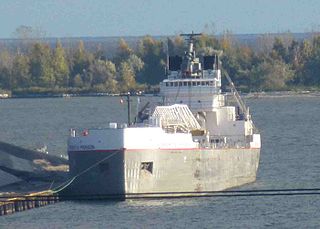
The Robert S. Pierson is a bulk carrier built for and operated on the North American Great Lakes. The vessel went through several owners and several names. In 2007 she was sold to Lower Lakes Towing, a Canadian company. Her last namesake was Robert Scott Pierson, the founder of the shipping firm Soo River Company. An earlier vessel named after Pierson operated from 1980 to 1982.

The lake freighter MV Saginaw was launched as John J. Boland in 1953, the third vessel to bear that name. James J. Boland was owned and operated by the American Steamship Company and constructed by Manitowoc Shipbuilding Company at Manitowoc, Wisconsin. In 1999, the ship was sold to Lower Lakes Towing and renamed Saginaw. The ship is currently in service.

Whitefish Bay is a self-unloading lake freighter that entered service with Canada Steamship Lines (CSL) in 2013. The vessel is the third of CSL's Trillium-class ships. Her sister ships are Baie Comeau, Baie St. Paul and Thunder Bay.

Pineglen was a bulk carrier owned and operated by Canada Steamship Lines. She was built at the Collingwood Shipyards, in Collingwood, Ontario in 1985, to a single superstructure lake freighter design. Initially named Paterson, the vessel was sold to Canada Steamship Lines in 2002 and renamed. Unlike more modern lake freighters she was built to a "straight-deck" design – i.e. she was not equipped with a self-unloading boom. The vessel was sold for scrap in 2017.
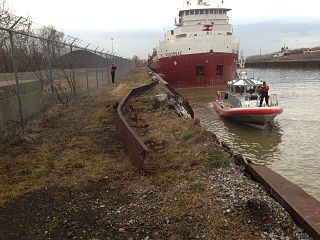
CSL Tadoussac is a lake freighter currently operated by Canada Steamship Lines (CSL) on the Great Lakes. She was launched in 1969. Initially named Tadoussac, following her refit in 2001, she was renamed CSL Tadoussac She was the last freighter built for CSL in the traditional two superstructure design, which puts her bridge up in the ship's bow. The vessel primarily transports iron ore and coal.
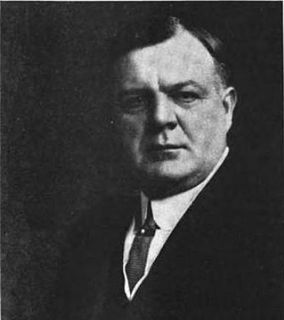
Harry Coulby was a British American businessman known as the "Czar of the Great Lakes" for his expertise in managing the Great Lakes shipping fleet of Pickands Mather & Company. and the Pittsburgh Steamship Company. After retiring, he served as the first mayor of the newly incorporated town of Wickliffe, Ohio. His former home, Coulallenby, now serves as the city hall of Wickliffe. He chose the design for Great Lakes ore carriers in 1905 that became the standard for the next 65 years, and was elected to the National Maritime Hall of Fame in 1984.
The Pickands Mather Group is an American company which provides shipping of coal and other bulk commodities, and the purchase, sale, and marketing of bulk coal. Founded in 1883 as Pickands Mather & Company, it once had the second largest shipping fleet on the Great Lakes in the 1910s and 1920s. The company was purchased by the Diamond Shamrock Corporation in 1968, which in turn sold it to the Moore-McCormack Resources in 1973. Moore-McCormack sold Pickands Mather's mining interests to Cleveland-Cliffs in 1986. Moore-McCormack then spun off the Interlake Steamship Company to James Barker and Paul R. Tregurtha in 1987. Pickands Mather was sold to a management group in 1992, and continues to operate as a private company.
The Interlake Steamship Company is an American freight ship company that operates a fleet on the Great Lakes in North America.

Augustus B. Wolvin was a 560 ft (170 m) long Great Lakes freighter that had a 63-year career on the Great Lakes. Augustus B. Wolvin was a product of the American Shipbuilding Company of Cleveland, Ohio. She was built for the Acme Steamship Company of Duluth, Minnesota.

The John Sherwin was an American steel hulled propeller driven Great Lakes freighter built in 1906 by the West Bay City Shipbuilding Company of Bay City, Michigan for service on the Great Lakes of North America. She was used to transport bulk cargoes such as coal, iron ore and grain. She served from her launching in 1906 to her scrapping in 1974, in Germany.

Algoma Provider was the penultimate name for a Canadian lake freighter, that served from 1963 to 2013, under the flag of several shipping lines. She was built to seawaymax dimensions at the Collingwood Shipyards in Collingwood, Ontario for Canada Steamship Lines. She was powered by a steam turbine, and was the company's last steam-powered vessel. Initially named Murray Bay, the ship was sold in 1994 to Upper Lakes Shipping, which renamed the vessel Canadian Provider. In 2011, Upper Lakes Shipping sold its entire fleet to Algoma Central, which renamed the lake freighter Algoma Provider. The vessel continued in service until 2013, when she was sold to be broken up for scrap. The ship was renamed Ovi for her journey to the scrapyard in Turkey. During her career, the ship carried bulk cargoes to destinations along the Saint Lawrence Seaway and Great Lakes.

The MV Kaye E. Barker is a self-discharging lake freighter owned and operated by the Interlake Steamship Company. She was originally built as the Edward B. Greene, and was later renamed Benson Ford before being sold to Interlake and named the Barker. It primarily hauls taconite pellets, stone, and coal across the North American Great Lakes.
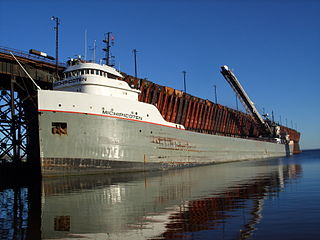
Michipicoten is a self-discharging lake freighter owned and operated by Canadian shipping firm Lower Lakes Towing. Michipicoten primarily hauls taconite from Marquette, Michigan to the Algoma Steel Mill in Sault Ste. Marie, Ontario. It has a capacity of 22,300 tons, a speed of 12 knots (14 mph), and a length of 689 feet 6 inches (210.2 m).